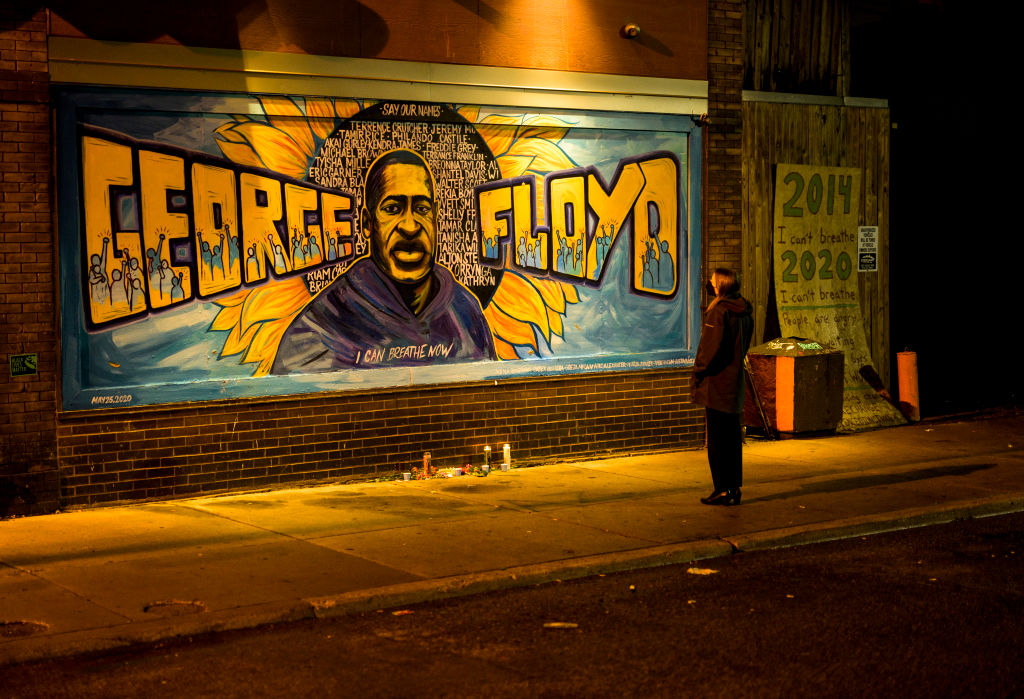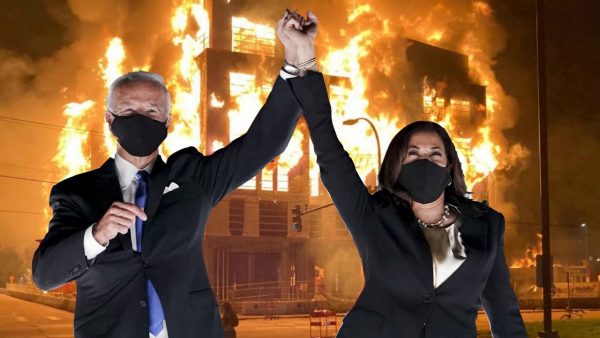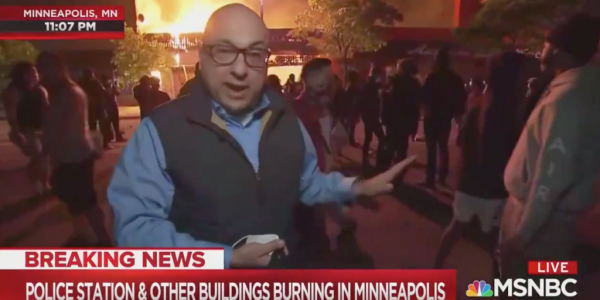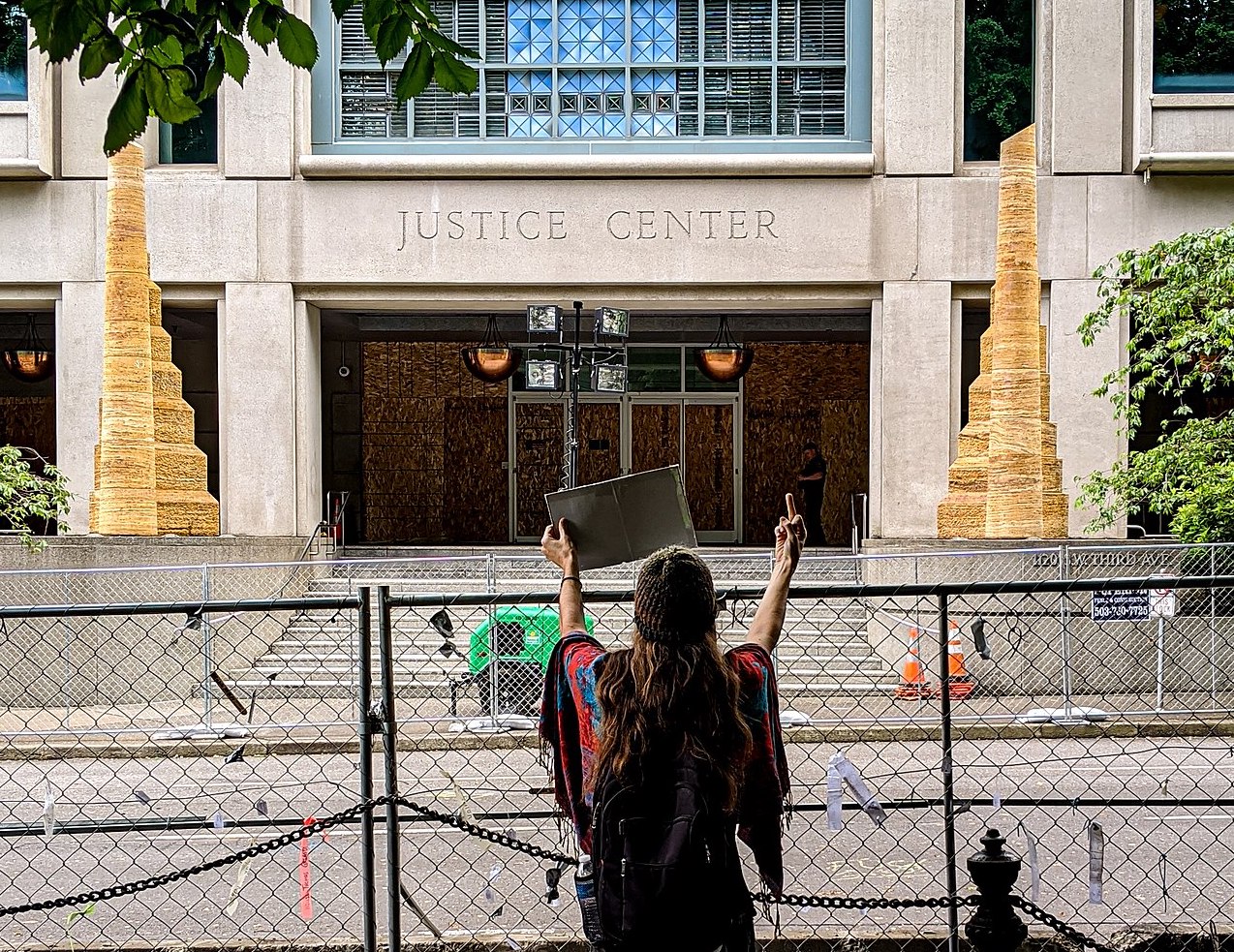How did we get here—and how will it end?
The Scapegoating of Derek Chauvin, Pt. II

We knew it all along that Officer Chauvin did not murder George Floyd.
This is the conclusion of a two-part essay. The first part can be read here.
In a previous article (Part I) I described the parade of evidence proving that George Floyd died of cardiopulmonary arrest resulting from his rampant drug use, heart disease, enlarged heart, and edematous lungs. I also showed how prosecutors knew that Officer Chauvin’s knee did not restrict the passage of air to Floyd’s lungs. This fact was not in dispute—the medical examiner testified that he informed prosecutors there was no physical evidence of asphyxiation.
Notwithstanding this evidence, the legacy media manufactured the narrative that Officer Chauvin killed Floyd by asphyxiating him: a patently false narrative nicely encapsulated in memetic and opportunistic “I can’t breathe” T-shirts and “8 minutes, 46 seconds” ball caps. This rhetoric implied that responding officers’ use of force was unlawful. As I show below, this view is entirely false, though it made for effective propaganda.
Responding officers (including Officer Chauvin, who arrived several minutes into the ordeal) handled Floyd’s arrest in a professional, dispassionate, and lawful manner. They managed to deescalate a tense and dangerous situation involving an erratic, powerful, and intoxicated suspect amidst an increasingly hostile and dangerous mob. They should be commended for their work. The bodycam footage proves it.
Radical and Explosive Violence
Though prosecutors are not present at arrests, many have reviewed police use of force incidents, as I did for New Jersey’s shooting response team before I became a federal prosecutor. Such reviews are multifaceted and involve, for example, viewing bodycam footage, interviewing witnesses, and understanding the findings of toxicology and medical examiner’s reports. In reviewing such incidents, DOJ’s standard is a good approximation of state and local standards: the question is whether use of force is “reasonable,” taking into account such factors as “whether the suspect poses an immediate threat” or “is actively resisting arrest.”
The analysis is not conducted in a vacuum. As the Supreme Court ruled:
The calculus of reasonableness must embody allowance for the fact that police officers are often forced to make split-second judgments—in circumstances that are tense, uncertain, and rapidly evolving—about the amount of force that is necessary in a particular situation…. The “reasonableness” of a particular use of force must be judged from the perspective of a reasonable officer on the scene, rather than with the 20/20 vision of hindsight.
Reviewing use of force incidents using the “reasonableness” standard helps one appreciate that the threat of violence faced by officers is real. Most people have no experience with radical and explosive violence. Like this neophyte, they are unqualified to reach conclusions about lawful police use of force. Without such experience it’s difficult to understand the danger presented by Floyd or to understand why restraining him was not only important but essential. Educate yourself by watching this, this, this, this, this, and this.
With DOJ’s and the Supreme Court’s “reasonableness” standard in mind, any experienced prosecutor reviewing the bodycam footage (excerpts available here, here, here, and here) in the Floyd case would observe the following:
When initially approached, Floyd is in the driver’s seat of a parked vehicle with the door closed and the window up (remember this when Floyd later claims he’s “claustrophobic”). Officer Thomas Lane taps on the window at which point Floyd reaches forward, down, and away from Officer Lane, who cannot see what Floyd is doing with his right hand. This movement was potentially deadly. In response, Officer Lane drew his firearm, a reasonable response to a potential threat. For the next 25 seconds, Floyd refused to show his right hand or to respond to Officer Lane’s lawful commands. The situation is tense, and Floyd’s actions are consistent with an intent to use deadly force. Officer Lane handled the situation professionally and reasonably.
Before any officer laid a hand on Floyd in the encounter, Floyd stated several times that his anxiety was impairing his breathing.
Floyd was large and strong and physically resisted Officer Kueng’s and Lane’s attempt to maneuver him into the police vehicle. Officers Chauvin and Thao arrived about three minutes into this struggle, at which point Chauvin attempted to assist the other officers in putting Floyd into the vehicle. Floyd’s ability to resist two officers for nearly three minutes and, with Chauvin’s arrival, three grown men for another full minute are sufficient to prove this. Erratic drug-fueled behavior plus physical power is a recipe for explosive and deadly violence and informs the reasonableness calculation.
It was during the above-described struggle that Floyd first stated “I can’t breathe,” minutes before Officer Chauvin used his knee to help restrain Floyd. This statement, together with Floyd’s earlier remarks about anxiety impairing his breathing, reveal that Floyd was in respiratory distress early in the encounter.
Floyd was acting erratically for psychological and drug-induced reasons. For example, during the entire encounter, Floyd cries at bizarre moments, pleads not to be shot when no weapons are drawn, absurdly claims he is claustrophobic when refusing to enter the police vehicle (absurd because he was encountered in a smaller vehicle), and repeatedly calls out for his deceased mother, apparently not realizing she was deceased. The toxicology results addressed in Part I prove Floyd was drowning in narcotics. All of this must be accounted for in assessing the reasonableness of officers’ use of force.
Not only was Floyd intoxicated, but the responding officers suspected as much, which would have increased their valid and reasonable perception of the danger he posed. Their knowledge is evidenced by the pipe they found in Floyd’s possession and their various questions to him (e.g., “Are you on something right now, because you are acting erratic?”).
As officers struggled with Floyd, the crowd grew, began making hostile threats, and encroached on the responding officers’ safety. Floyd was so strong that even as he was dying, he effortlessly lifted Chauvin’s entire body on at least two occasions.
There was never a moment during the entire nine-minute encounter when Floyd complied with a single officer’s commands. Floyd resisted physically and verbally the entire time even though officers repeatedly told him to stop doing so. He frequently resorted to aggressive physical movements even though he was handcuffed.
The officers were calm and collected throughout the arrest, repeatedly exercising sound judgment. For example, when they realized they could not compel Floyd into the police vehicle, they opted for an MRT instead. MRT means “maximal restraint technique” and involves tying a subject’s feet to his hands. The three officers were able to maneuver Floyd to the ground, with Chauvin applying his knee to the back of Floyd’s shoulder (not his neck, as commonly believed), Keung kneeling on his back, and Lane restraining Floyd’s legs. When they realized that this was sufficient, they again adapted their approach and abandoned the more severe MRT. At the same time, they radioed for an ambulance showing dispassionate judgment in a stressful situation.
During the next five minutes, Floyd repeatedly stated “I can’t breathe.” In light of the toxicology and medical examiner’s report, prosecutors would have known that this was, in fact, true—or at least that Floyd was struggling to breathe. But they also knew that his difficulty breathing was the consequence of his drug use, heart disease, enlarged heart, and edematous lungs. Nobody involved in the trial disputed this point.
In short, the video evidence shows that the officers continuously and systematically downgraded the amount of force they were using against a more powerful, psychologically unstable, and intoxicated suspect, all while in the presence of an increasingly hostile crowd. Short of letting Floyd go, it’s not clear how they could have used less force. This easily satisfies the “reasonableness” standard.
The social conflagration following Floyd’s death was incoherent from the outset. It presupposed that systematically racist law enforcement murdered a man due to his race. If this were true, it would demand justice. But none of it is true. Floyd wasn’t murdered, and there is no support for the canard that law enforcement is systematically racist. In reality, the belief that Floyd was murdered is a childish fantasy indulged by low-information people and opportunists looking for any excuse to leverage their self-righteous anger in stimulating ways. Riots and looting ensued.
But something else happened as well. Murals to Floyd appeared in places like the West Bank, Afghanistan, Pakistan, Kenya, Iran, Syria, and China (which never fails to seize an opportunity to enervate America by fueling our fantastical racial grievance industry). So amorphous was Floyd as a symbol that his image—even the mere mention of his name—became sufficiently versatile to stand in for everything from the genocidal delusions of Hamas to the cyclical gang wars of America’s most violent cities, from the PowerPoint presentations of Fortune 100 human resource departments to the inane pronouncements of the federal gerontocracy, from race grifting harpies boring us with such banalities as “Is Your DEI Strategy Performative or Sustainable?” to the strategic opportunism of foreign intelligence services.
There was something ritualistic about the process by which self-loathing white liberals, antisemites of all stripes, Hamas terrorists, London immigrants, and beleaguered African Americans became political allies in their simultaneous scapegoating of Officer Chauvin and apotheosis of George Floyd. By the strange logic of mythic sacrifice, as the public learned of Floyd’s many character faults, it felt compelled to love him even more, while caring less for the truth of Chauvin’s innocence. It was as though the putative evil of Chauvin had to be matched in magnitude only by the saintly accomplishments of Floyd. Through this prolonged public madness, Floyd became Christ-like, lost his status as a mere mortal, and transcended time and space to become a symbol of…nothing and anything. Simultaneously, Chauvin—caricaturized by this photo—became a scapegoat. He became the symbol of all the putative evils that our ruling elite pretend are inhibiting us from realizing their utopian schemes.
We Knew it All Along
It is almost unbelievable that the mundane arrest of an ordinary lowlife in a nondescript city should serve as the seed that birthed months of opportunistic nationwide looting, suspiciously public displays of grief, predictable piling-on by politicians loathe to let a crisis go to waste, self-defeating initiatives to defund the police, a trillion-dollar effort among corporate and academic elites to establish a new caste system, global anti-American protests by people who would ordinarily risk life and limb to emigrate here, and strategic meddling by the foreign intelligence services of America’s adversaries.
Yet that is exactly what happened, even though it was all based on a simple lie. From soup to nuts, as they say, all of it. A plain and simple lie that started in Minneapolis and grew to astonishing proportions, circling the planet at the speed of light for more than three years while serving as the justification for everything from property crimes to terrorism, from human rights violations to realpolitik by dictatorships intent on displacing the pax Americana.
It happened because good and decent people, right here in the United States, lacked the courage to state the truth: Officer Chauvin did not murder George Floyd. We knew it all along.
The American Mind presents a range of perspectives. Views are writers’ own and do not necessarily represent those of The Claremont Institute.
The American Mind is a publication of the Claremont Institute, a non-profit 501(c)(3) organization, dedicated to restoring the principles of the American Founding to their rightful, preeminent authority in our national life. Interested in supporting our work? Gifts to the Claremont Institute are tax-deductible.
If they don't act, white Americans will soon be subsidizing their own destruction.
The collapse of academic standards is a function of racial preferences.
Don't believe your lying eyes.
Serf's up.
Why can’t Democrat leaders see what we all see?






